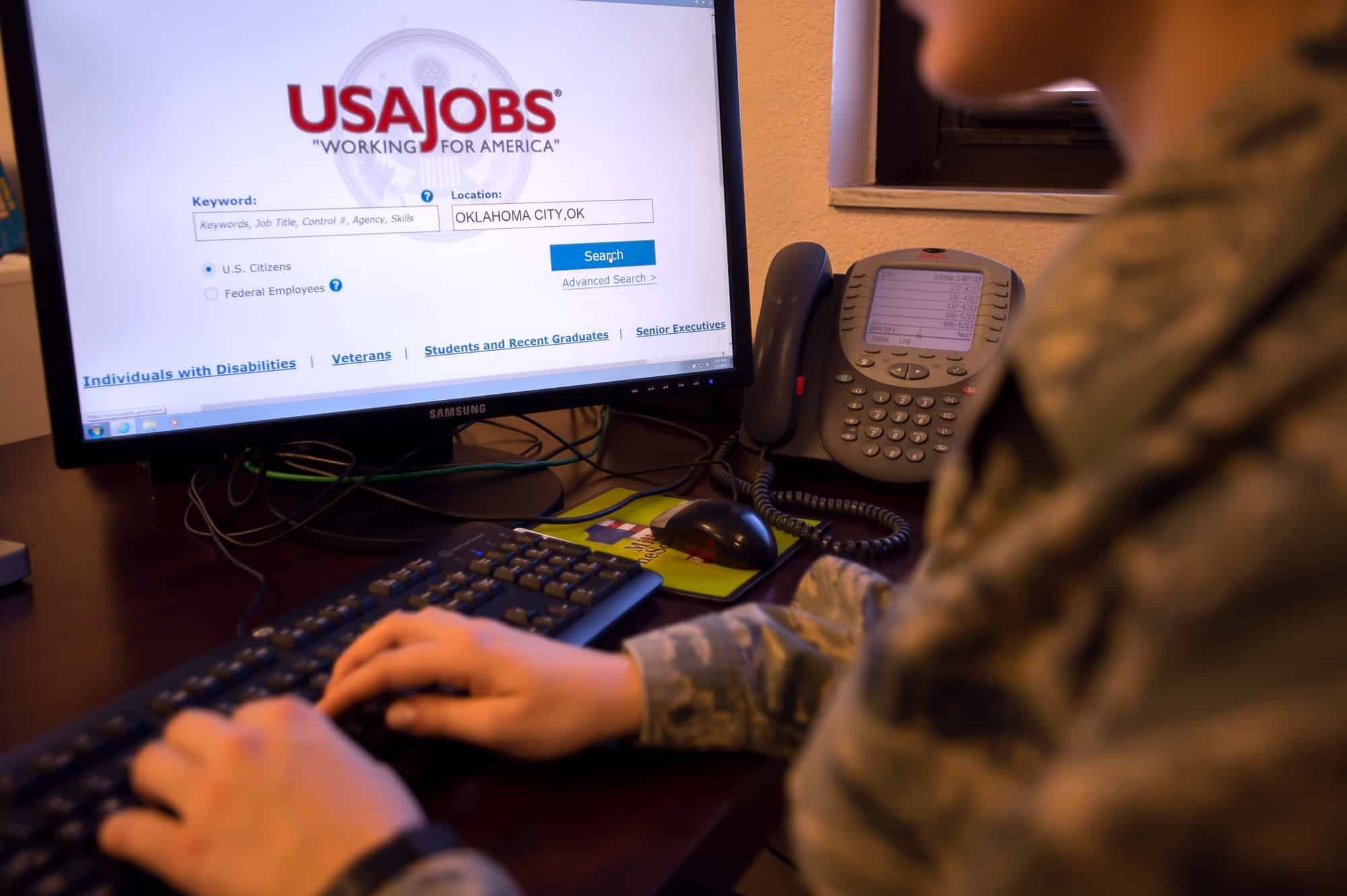- Workplace Statistics
- Time Management Statistics
- Employee Wellness Statistics
- Employment Discrimination Statistics
- Employee Recognition Statistics
- Employee Referral Statistics
- Workplace Violence Statistics
- Gamification Statistics
- Employee Feedback Statistics
- Agile Statistics
- Productivity Statistics
- Meeting Statistics
- Cell Phones At Work Statistics
- Social Media At Work Statistics
- Workplace Injury Statistics
- Workplace Stress Statistics
- Leadership Statistics
- Workplace Collaboration Statistics
- Wasting Time At Work Statistics
- Job Satisfaction Statistics
- Paid Holiday Statistics
Research Summary. Almost everyone wants to be recognized for their work, whether they get paid to do it or not. Because of this, companies are realizing that recognizing employees is a vital part of keeping their workers happy, productive, and committed to the organization. Here are the key statistics on employee recognition:
-
29% of employees haven’t received recognition for good work in over a year, if at all.
-
80% of employees would work harder if they felt better appreciated.
-
Strong employee recognition programs reduce turnover rates by 31%.
-
Employees who are recognized are almost six times more likely to stay at their jobs than those who aren’t.
-
37% of employees report that the best way to improve their engagement is for their superiors to give them recognition.
For further analysis, we broke down the data in the following ways:
Retention | Employee Opinions | Employer Benefits | Methods
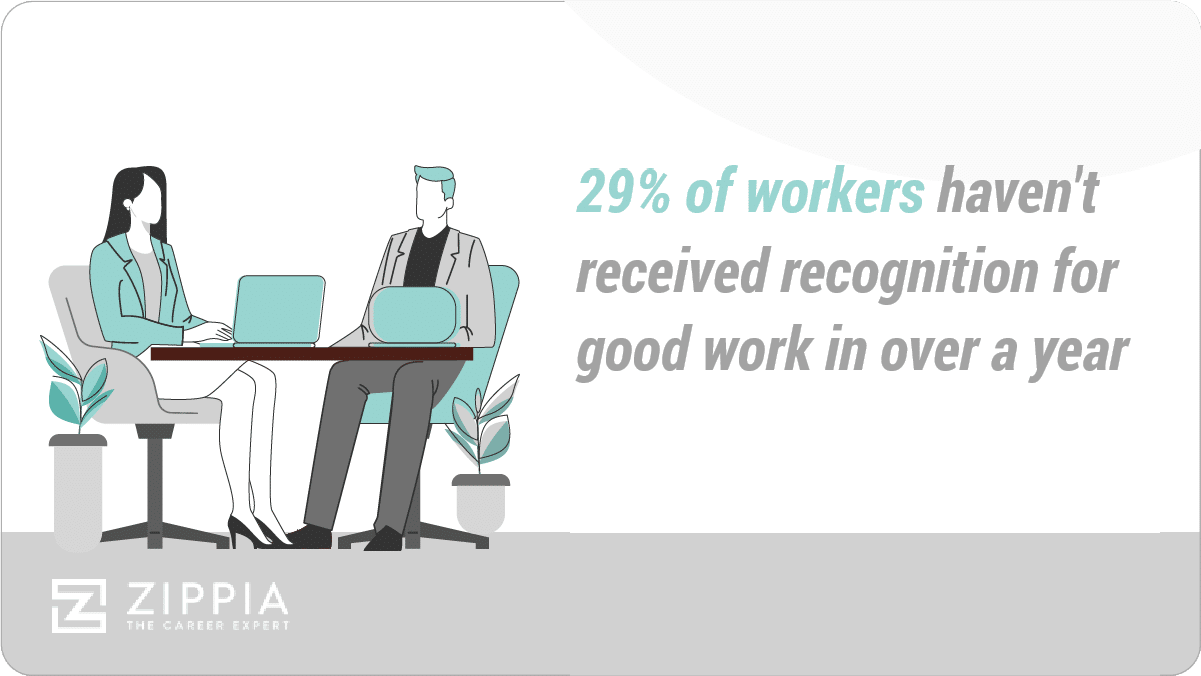
General Employee Recognition Statistics
-
37% of employees report that employee recognition is the most important thing their manager or company can do to motivate them to produce great work.
Recognition is by far the most popular motivator to do great work that employees listed, and it is followed by 13% of employees saying they are self-motivated, 12% saying they need inspiration to do great work, and 12% saying that autonomy is their biggest motivator.
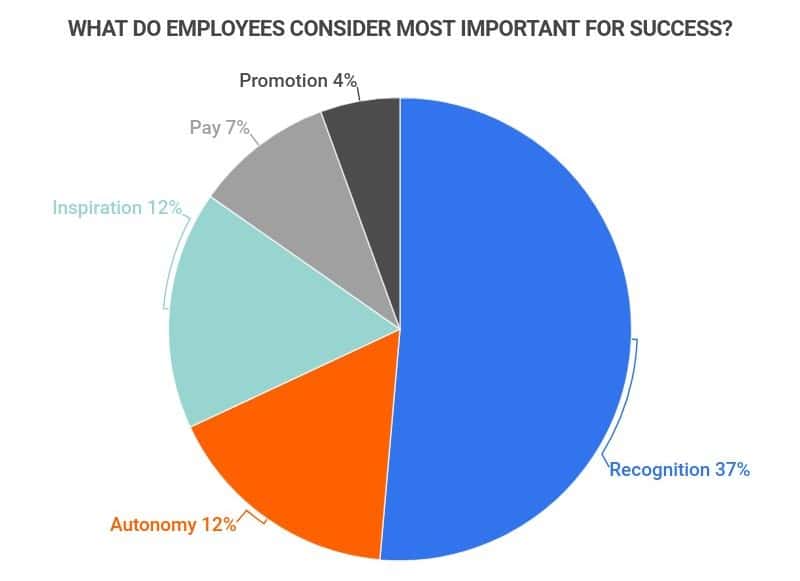
-
80% of employees say they’re motivated to work harder when they’re recognized for their work by their superiors.
In contrast, not even 40% say that a demanding boss or fear of losing their jobs motivates them to work harder.
-
Employees who think they’ll be recognized are 2.7 times more likely to have a high engagement at work.
In addition, knowing that they’ll be recognized for their efforts is one of the top ten driving factors behind employee engagement. Also on the list are similar ideas such as knowing that senior leaders value the people who work for them and knowing that their opinions count.
Employee Recognition Statistics By Retention
-
44% of surveyed employees who said they were planning to leave their jobs cited a lack of recognition as their main reason.
-
69% of employees planning to quit their jobs said that receiving recognition and rewards would cause them to choose to stay at their current positions.
-
A lack of recognition is the number three reason why employees leave their jobs.
-
Employees who don’t feel recognized are five times more likely to say they’re “extremely likely” to look for work elsewhere than employees who feel recognized.
Employee Recognition Statistics By Employee Opinions
-
Employees who feel recognized at work are 2.6 times more likely to say that they believe promotions at their workplace are fair.
In addition, they’re also more likely to describe the organizations they work for positively, while most of those who said they don’t feel recognized at work negatively described their employers.
-
39% of surveyed employees say they aren’t recognized enough at work.
In addition, 15% say they are recognized almost frequently enough, 42% say that they’re recognized just the right amount, and just 3% say they’re recognized too frequently. So, if you’re able to recognize your employees, don’t worry about overdoing it so much as not doing it enough.
-
29% of employees say they don’t receive recognition for their work.
Over a quarter of employees haven’t been recognized for their work, and 17% say they receive it annually, which isn’t much better.
20% say they’re recognized quarterly, 11% say they receive recognition weekly, and 2% say they do daily.
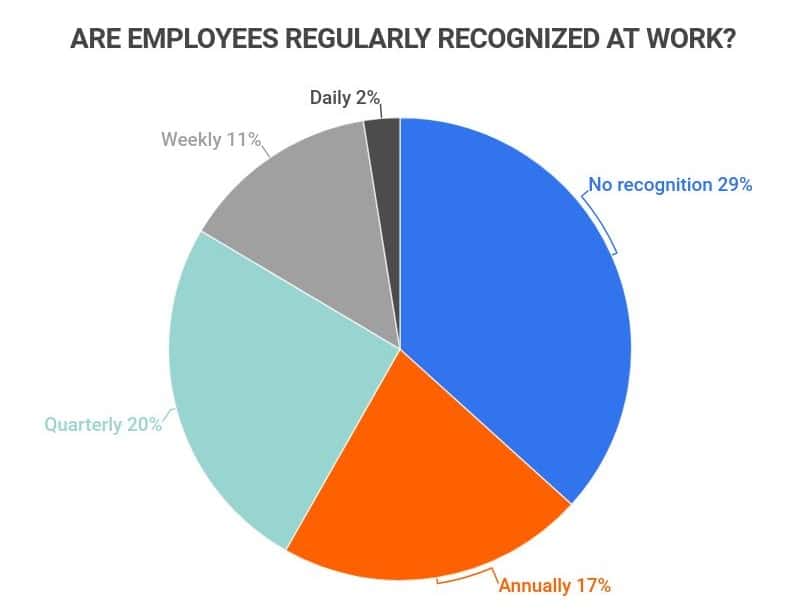
-
28% of employees say recognition from their manager is the most memorable.
This is followed by 24% who say the same about the recognition from a high-level company leader or CEO and 12% who say that from their manager’s manager. Others say their most memorable recognition came from a customer (10%), their peers (12%), or another source altogether (17%).
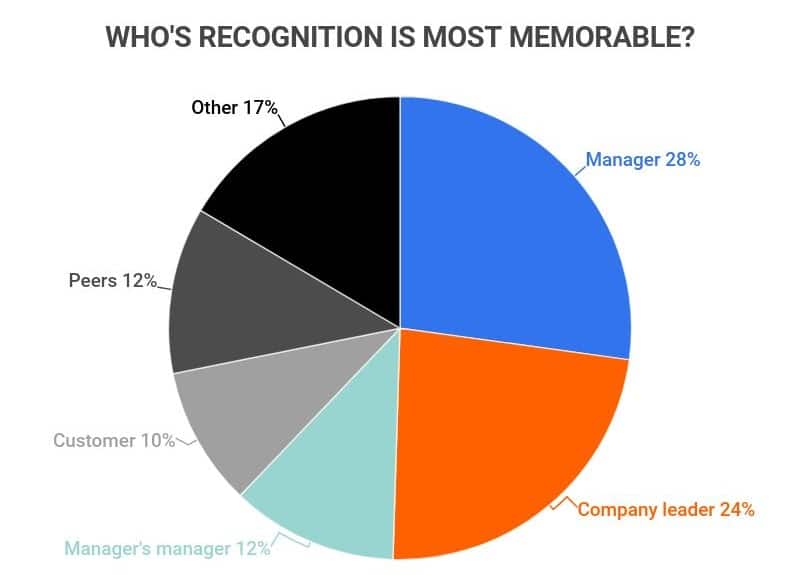
Employee Recognition Statistics By Employer Benefits
-
The top 20% of companies that have strong cultures of employee recognition have 31% lower voluntary turnover rates than their competitors.
-
Just improving recognition by 15% in a company can increase its margins by 2%.
-
Organizations with employee recognition programs see employee performance, engagement, and productivity increase by 14% more than those that don’t have these programs.
-
Happy workers are 13% more productive than unhappy workers.
-
Companies with good employee recognition strategies are 48% more likely to have high employee engagement rates.
Employee Recognition Statistics By Methods
-
On average, companies budget 2% of payroll for employee recognition and reward programs.
The median amount is 1%, but some spend up to 10% on these programs.
-
Annually, businesses spend about $3.25 billion on merchandise for employees.
This merchandise is used to incentivize employees, usually part of recognition programs.
-
Tenure-based recognition makes up 87% of companies’ recognition programs.
This means that 87% of organizations give their employees recognition or awards for working at the company for an extended period. However, only 58% of employees know about these programs, showing that many miss the mark in helping employees feel recognized.
-
65% of employees prefer non-cash incentives from their employers.
It should be noted that these employees answered this way when their incentives and awards were personally meaningful to them, so they aren’t just saying that they would rather have a $50 Bluetooth speaker than $50 in cash.
They say that their employer taking the time to choose an award that they’d appreciate and present it meaningfully means more to them than getting cash.
-
46% of employees say that an unexpected reward like a snack, lunch, or thank you note from their bosses would make them feel more appreciated.
In addition, 24% say they’d feel more appreciated if the company hosted an event such as a holiday party or a simple cocktail hour.
Employee Recognition Statistics FAQs
-
What percentage of employees feel recognized at work?
60% of employees feel recognized at work. Of these, 15% say they’re recognized almost frequently enough, 42% say they’re recognized just the right amount, and 3% say they’re recognized too frequently.
Even though 60% is more than half of all employees, just 45% say they feel they’ve received enough or too much recognition from their workplaces. This is too low, especially since such a large percentage of employees don’t feel recognized.
For employers who are worried about going overboard with their recognition efforts, having just 3% of employees think that you do too much to recognize their work is a fair price to pay for having the remaining 97% feel appreciated and motivated to do more good work.
In addition, it’s very rare to hear someone say they’re leaving their job because they felt too appreciated, so it’s better to err on the side of too much than too little.
-
How do you measure employee recognition?
You measure employee recognition by asking employees if they feel recognized. While you can measure some amount of employee recognition by looking at how many programs the company has in place to show appreciation to its employees, those numbers don’t matter if the employees still feel unseen.
A company could spend millions on gifts, parties, and awards for its employees, and while that is a measure of how seriously the company takes employee recognition, it doesn’t do any good if employees don’t feel recognized and appreciated.
Conducting a survey and asking employees if they feel recognized by their superiors is the far more accurate way of measuring how well a company is doing in this area.
-
What percentage of companies have recognition programs?
80% of companies have recognition programs. The type of recognition these programs offer can vary greatly, as each company will recognize their employees for different actions and reward them in different ways.
For example, 87% of recognition programs involve rewarding employees for tenure. Others recognize employees for innovation, excellent work, or breaking records.
Similarly, some companies give out pins and certificates as a means of recognition, while others throw events or give out bonuses or free trips. Many do a combination of these, depending on their budgets.
-
Why is employee recognition important?
Employee recognition is important because it helps employees feel valued, increasing engagement and productivity and decreasing voluntary turnover.
Companies in the top 20% of those with strong employee recognition programs have voluntary turnover rates that are 31% lower than their competitors’. In addition, companies that have these programs in any capacity often see employee performance, engagement, and productivity go up by 14%.
Even a little effort in this area goes a long way, as companies that improve their recognition efforts by 15% often see their margins increase by 2%.
This is because employees who feel like their hard work is noticed are much more likely to give their jobs their best effort rather than coasting or looking for an opportunity elsewhere.
-
Do employee recognition programs work?
Yes, employee recognition programs work. Companies that have these programs see employee performance, engagement, and productivity rates that are 14% higher than those in companies that don’t have recognition programs.
However, it’s important that these programs recognize employees in a way that is meaningful to them. Otherwise, they won’t have much of an impact.
For example, many employee recognition programs give out cash rewards to their workers, but in reality, 65% of employees would rather have a personalized, non-cash award instead.
Note that personalized doesn’t necessarily mean getting a Bluetooth speaker with their name on it instead of a plain one, but it does mean finding something that they’d personally enjoy and presenting it to them in a meaningful way.
That doesn’t mean that monetary recognition should be nixed – many people still prefer this means of recognition – it just means that companies should be aware that just because they throw cash at employees doesn’t mean that their workers feel appreciated.
-
How does employee recognition affect productivity?
Employee recognition affects productivity by increasing it. Companies that recognize their employees see productivity, performance, and engagement levels 14% higher than their competitors, who don’t have employee recognition programs.
In addition, being recognized increases employees’ happiness, and happy workers are 13% more productive than unhappy ones. 80% of employees also say they’re motivated to work harder when their work is recognized, while just 40% say that a demanding boss or a fear of losing their jobs motivates them to do the same.
Conclusion
Companies often forget to recognize their employees’ efforts, as 29% of employees say they haven’t received recognition for good work in over a year, if at all. By not making an effort to recognize their employees, companies are harming themselves more than they might think.
Those with employee recognition programs see employee productivity, engagement, and performance go up, and voluntary turnover rates go down.
Employees themselves admit that they do better work when they receive recognition, as 80% say they work harder and 37% say they produce better work when they know their superiors will recognize their efforts.
References
-
Haiilo. “8 Employee Engagement Statistics You Need To Know in 2022 [Infographic].” Accessed on March 15, 2022.
-
Great Place To Work. “Creating a Culture of Recognition.” Accessed on March 15, 2022.
-
HuffPost. “Appreciation Motivates Employees To Work Harder, Study Says.” Accessed on March 15, 2022.
-
Quantum Workplace. “What are the Top Drivers of Employee Engagement?” Accessed on March 15, 2022.
-
Achievers. “Achievers Survey Finds Without Recognition, Expect Employee Attrition in 2018.” Accessed on March 15, 2022.
-
15Five. “Top 10 Reasons Why Employees Leave Their Jobs (Infographic).” Accessed on March 15, 2022.
-
SurveyMonkey. “Can Employee Recognition Help You Keep Them Longer?” Accessed on March 15, 2022.
-
Authentic Recognition. “How Frequently Should You Give Recognition?” Accessed on March 15, 2022.
-
Gallup. “Employee Recognition: Low Cost, High Impact.” Accessed on March 15, 2022.
-
Forbes. “New Research Unlocks the Secret of Employee Recognition.” Accessed on March 15, 2022.
-
Deloitte. “Recognition Programmes: Are They Important?” Accessed on March 15, 2022.
-
University of Oxford. “Happy Workers are 13% More Productive.” Accessed on March 15, 2022.
-
Jostle. “Improve Employee Engagement Using Recognition and Reward.” Accessed on March 15, 2022.
-
Incentra. “Budgeting for Employee Engagement and Recognition Programs.” Accessed on March 15, 2022.
-
Statista. “Annual Spend on Incentives by Businesses in the United States as of December 2015, by Business Sector and Type.” Accessed on March 15, 2022.
-
Forbes. “New Research Unlocks the Secret of Employee Recognition.” Accessed on March 15, 2022.
-
Northstar Meetings Group. “Cash Isn’t King: A Major Study Conducted by the IMA and IRF Refutes Myth That Cash is the Number One Motivator.” Accessed on March 15, 2022.
- Workplace Statistics
- Time Management Statistics
- Employee Wellness Statistics
- Employment Discrimination Statistics
- Employee Recognition Statistics
- Employee Referral Statistics
- Workplace Violence Statistics
- Gamification Statistics
- Employee Feedback Statistics
- Agile Statistics
- Productivity Statistics
- Meeting Statistics
- Cell Phones At Work Statistics
- Social Media At Work Statistics
- Workplace Injury Statistics
- Workplace Stress Statistics
- Leadership Statistics
- Workplace Collaboration Statistics
- Wasting Time At Work Statistics
- Job Satisfaction Statistics
- Paid Holiday Statistics





